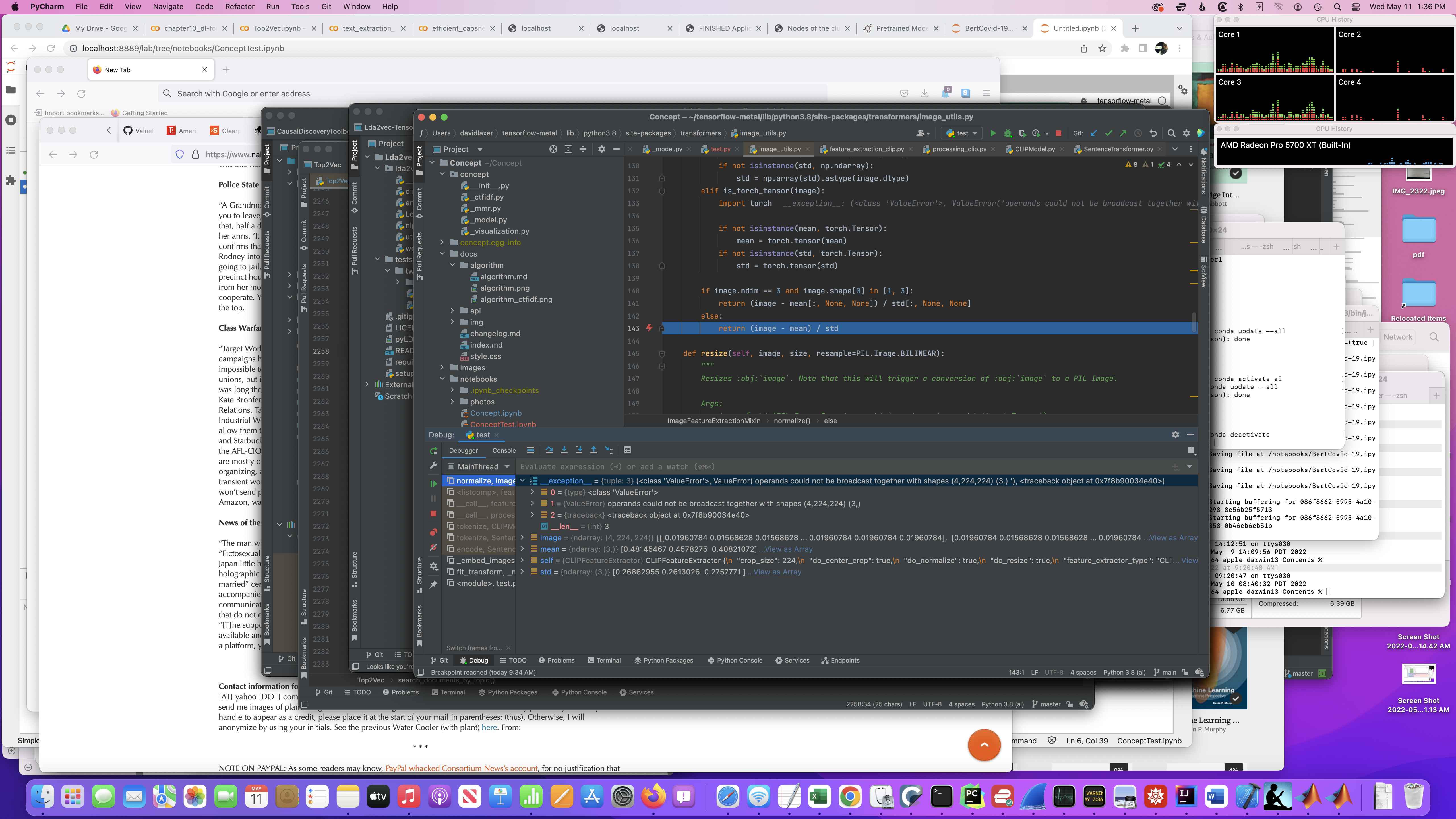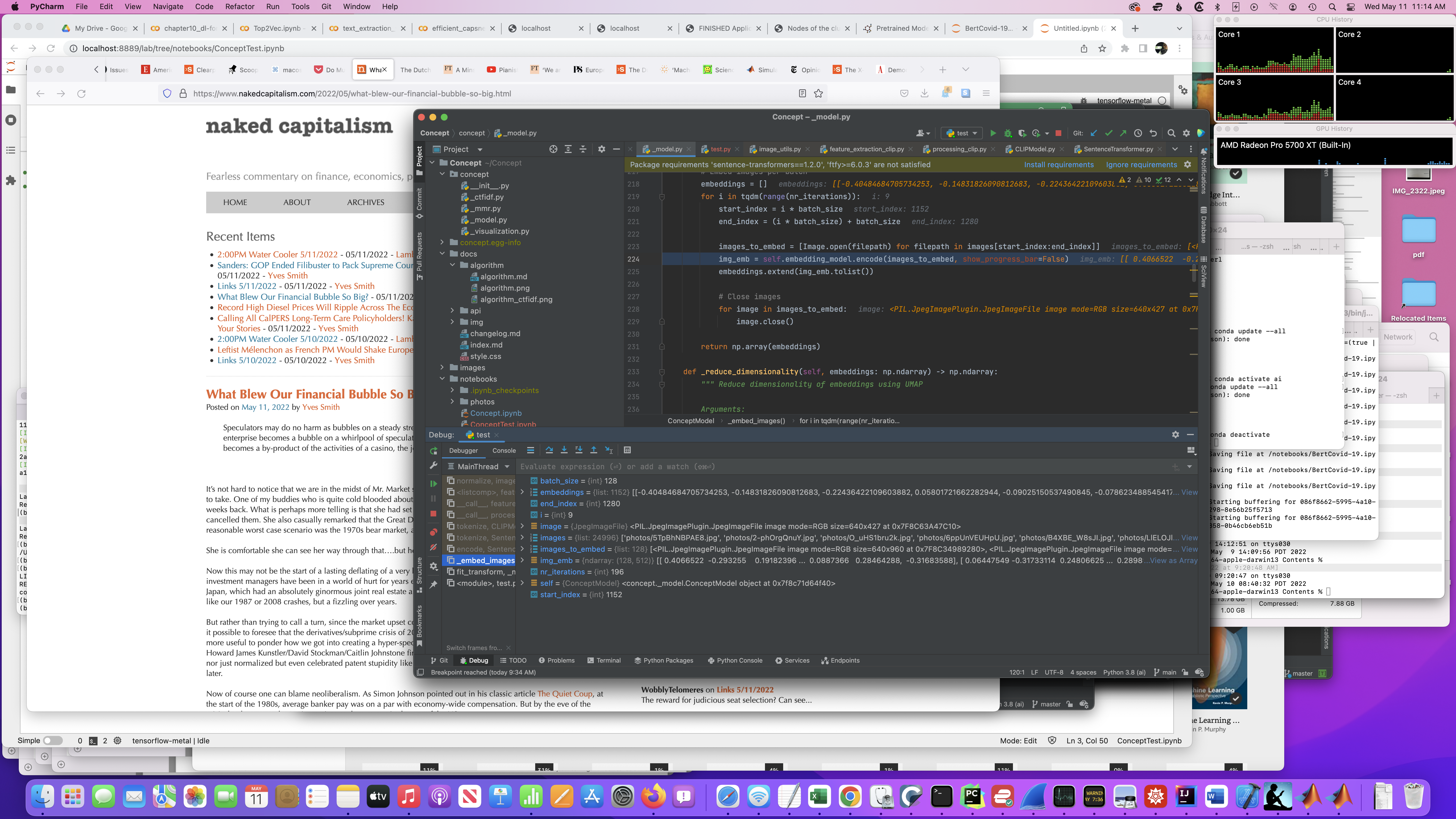Running a Concept example on OS S Monterey 12.3.1
...Transformers/Image_utils #143:
return (image - mean) / std
image is (4,224,224)
mean is (3,)
std is (3,)

Python 3.8.13
% pip show tensorflow_macos
WARNING: Ignoring invalid distribution -umpy (/Users/davidlaxer/tensorflow-metal/lib/python3.8/site-packages)
Name: tensorflow-macos
Version: 2.8.0
Summary: TensorFlow is an open source machine learning framework for everyone.
Home-page: https://www.tensorflow.org/
Author: Google Inc.
Author-email: [email protected]
License: Apache 2.0
Location: /Users/davidlaxer/tensorflow-metal/lib/python3.8/site-packages
Requires: absl-py, astunparse, flatbuffers, gast, google-pasta, grpcio, h5py, keras, keras-preprocessing, libclang, numpy, opt-einsum, protobuf, setuptools, six, tensorboard, termcolor, tf-estimator-nightly, typing-extensions, wrapt
Required-by:
pip show sentence_transformers
WARNING: Ignoring invalid distribution -umpy (/Users/davidlaxer/tensorflow-metal/lib/python3.8/site-packages)
Name: sentence-transformers
Version: 2.1.0
Summary: Sentence Embeddings using BERT / RoBERTa / XLM-R
Home-page: https://github.com/UKPLab/sentence-transformers
Author: Nils Reimers
Author-email: [email protected]
License: Apache License 2.0
Location: /Users/davidlaxer/tensorflow-metal/lib/python3.8/site-packages
Requires: huggingface-hub, nltk, numpy, scikit-learn, scipy, sentencepiece, tokenizers, torch, torchvision, tqdm, transformers
Required-by: bertopic, concept
% pip show transformers
WARNING: Ignoring invalid distribution -umpy (/Users/davidlaxer/tensorflow-metal/lib/python3.8/site-packages)
Name: transformers
Version: 4.11.3
Summary: State-of-the-art Natural Language Processing for TensorFlow 2.0 and PyTorch
Home-page: https://github.com/huggingface/transformers
Author: Thomas Wolf, Lysandre Debut, Victor Sanh, Julien Chaumond, Sam Shleifer, Patrick von Platen, Sylvain Gugger, Suraj Patil, Stas Bekman, Google AI Language Team Authors, Open AI team Authors, Facebook AI Authors, Carnegie Mellon University Authors
Author-email: [email protected]
License: Apache
Location: /Users/davidlaxer/tensorflow-metal/lib/python3.8/site-packages
Requires: filelock, huggingface-hub, numpy, packaging, pyyaml, regex, requests, sacremoses, tokenizers, tqdm
Required-by: sentence-transformers
Here's the code:
import os
import glob
import zipfile
from tqdm import tqdm
from sentence_transformers import util
# 25k images from Unsplash
img_folder = 'photos/'
if not os.path.exists(img_folder) or len(os.listdir(img_folder)) == 0:
os.makedirs(img_folder, exist_ok=True)
photo_filename = 'unsplash-25k-photos.zip'
if not os.path.exists(photo_filename): # Download dataset if does not exist
util.http_get('http://sbert.net/datasets/' + photo_filename, photo_filename)
# Extract all images
with zipfile.ZipFile(photo_filename, 'r') as zf:
for member in tqdm(zf.infolist(), desc='Extracting'):
zf.extract(member, img_folder)
img_names = list(glob.glob('photos/*.jpg'))
from concept import ConceptModel
concept_model = ConceptModel()
concepts = concept_model.fit_transform(img_names)
B/s]
0%| | 0/196 [00:00<?, ?it/s]/Users/davidlaxer/tensorflow-metal/lib/python3.8/site-packages/transformers/feature_extraction_utils.py:158: UserWarning: Creating a tensor from a list of numpy.ndarrays is extremely slow. Please consider converting the list to a single numpy.ndarray with numpy.array() before converting to a tensor. (Triggered internally at ../torch/csrc/utils/tensor_new.cpp:201.)
tensor = as_tensor(value)
5%|█▉ | 9/196 [02:21<48:54, 15.69s/it]
---------------------------------------------------------------------------
ValueError Traceback (most recent call last)
Input In [2], in <cell line: 3>()
1 from concept import ConceptModel
2 concept_model = ConceptModel()
----> 3 concepts = concept_model.fit_transform(img_names)
File ~/Concept/concept/_model.py:120, in ConceptModel.fit_transform(self, images, docs, image_names, image_embeddings)
118 # Calculate image embeddings if not already generated
119 if image_embeddings is None:
--> 120 image_embeddings = self._embed_images(images)
122 # Reduce dimensionality and cluster images into concepts
123 reduced_embeddings = self._reduce_dimensionality(image_embeddings)
File ~/Concept/concept/_model.py:224, in ConceptModel._embed_images(self, images)
221 end_index = (i * batch_size) + batch_size
223 images_to_embed = [Image.open(filepath) for filepath in images[start_index:end_index]]
--> 224 img_emb = self.embedding_model.encode(images_to_embed, show_progress_bar=False)
225 embeddings.extend(img_emb.tolist())
227 # Close images
File ~/tensorflow-metal/lib/python3.8/site-packages/sentence_transformers/SentenceTransformer.py:153, in SentenceTransformer.encode(self, sentences, batch_size, show_progress_bar, output_value, convert_to_numpy, convert_to_tensor, device, normalize_embeddings)
151 for start_index in trange(0, len(sentences), batch_size, desc="Batches", disable=not show_progress_bar):
152 sentences_batch = sentences_sorted[start_index:start_index+batch_size]
--> 153 features = self.tokenize(sentences_batch)
154 features = batch_to_device(features, device)
156 with torch.no_grad():
File ~/tensorflow-metal/lib/python3.8/site-packages/sentence_transformers/SentenceTransformer.py:311, in SentenceTransformer.tokenize(self, texts)
307 def tokenize(self, texts: Union[List[str], List[Dict], List[Tuple[str, str]]]):
308 """
309 Tokenizes the texts
310 """
--> 311 return self._first_module().tokenize(texts)
File ~/tensorflow-metal/lib/python3.8/site-packages/sentence_transformers/models/CLIPModel.py:71, in CLIPModel.tokenize(self, texts)
68 if len(images) == 0:
69 images = None
---> 71 inputs = self.processor(text=texts_values, images=images, return_tensors="pt", padding=True)
72 inputs['image_text_info'] = image_text_info
73 return inputs
File ~/tensorflow-metal/lib/python3.8/site-packages/transformers/models/clip/processing_clip.py:148, in CLIPProcessor.__call__(self, text, images, return_tensors, **kwargs)
145 encoding = self.tokenizer(text, return_tensors=return_tensors, **kwargs)
147 if images is not None:
--> 148 image_features = self.feature_extractor(images, return_tensors=return_tensors, **kwargs)
150 if text is not None and images is not None:
151 encoding["pixel_values"] = image_features.pixel_values
File ~/tensorflow-metal/lib/python3.8/site-packages/transformers/models/clip/feature_extraction_clip.py:150, in CLIPFeatureExtractor.__call__(self, images, return_tensors, **kwargs)
148 images = [self.center_crop(image, self.crop_size) for image in images]
149 if self.do_normalize:
--> 150 images = [self.normalize(image=image, mean=self.image_mean, std=self.image_std) for image in images]
152 # return as BatchFeature
153 data = {"pixel_values": images}
File ~/tensorflow-metal/lib/python3.8/site-packages/transformers/models/clip/feature_extraction_clip.py:150, in <listcomp>(.0)
148 images = [self.center_crop(image, self.crop_size) for image in images]
149 if self.do_normalize:
--> 150 images = [self.normalize(image=image, mean=self.image_mean, std=self.image_std) for image in images]
152 # return as BatchFeature
153 data = {"pixel_values": images}
File ~/tensorflow-metal/lib/python3.8/site-packages/transformers/image_utils.py:143, in ImageFeatureExtractionMixin.normalize(self, image, mean, std)
141 return (image - mean[:, None, None]) / std[:, None, None]
142 else:
--> 143 return (image - mean) / std
ValueError: operands could not be broadcast together with shapes (4,224,224) (3,)
The exception is in the normalize() function ... I believe in the 9th Pil image:










